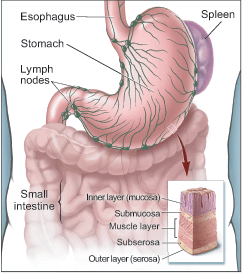|
The Stomach
The
stomach
is part of the
digestive system.
It is a hollow
organ
in the upper
abdomen,
under the ribs.
The wall of the stomach has five layers:
-
Inner layer or lining
(mucosa):
Juices made by
glands
in the inner layer help
digest food. Most stomach cancers begin in this layer.
-
Submucosa: This is the support tissue for the inner layer.
-
Muscle layer: Muscles in this layer create a rippling motion that mixes and
mashes food.
-
Subserosa: This is the support tissue for the outer layer.
-
Outer layer (serosa): The outer layer covers the stomach. It holds the stomach
in place.
Food moves from the mouth through the
esophagus
to reach the stomach. In the
stomach, the food becomes liquid. The liquid then moves into the
small intestine, where it is digested even more.

This picture shows the stomach and nearby organs.
|
< Previous Section | Next Section > |
